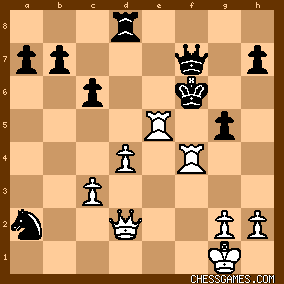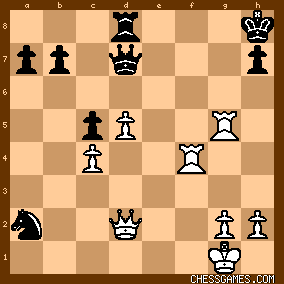|
< Earlier Kibitzing · PAGE 2 OF 2 ·
Later Kibitzing> |
| Sep-27-17 | | BxChess: The line 29. Rxf4+ Kg7 30. Rxg5+ Kh8 31. d5 Qxd5 32. Rxd5 cxd5 33. Rg4 also wins |
|
Sep-27-17
 | | FSR: <nalinw> Sorry, after 29...Kg6, 30.Rg4 is one of the few ways <not> to win, since Black has 30...Qxg4. I am not surprised that <patzer2> and <ruzon> found faster ways to win than my suggestion. |
|
| Sep-27-17 | | Altairvega: I solved it as in the game. I liked because a king's gambit opening! |
|
| Sep-27-17 | | Cheapo by the Dozen: I made it really easy on myself, by not looking for a best line if Black declines the sacrifice. If White doesn't play the puzzle move, he's slightly behind in material, and needs to play passively to defend d4. But if he does play it and Black declines, then 29 Rxf4+ Kg6
30 R(f)e4
leaves him slightly ahead in material with a dangerous attack. That's enough of a swing for me to declare the clear best move has been found. We can worry about what comes next while Black is considering whether to accept. :) |
|
| Sep-27-17 | | Walter Glattke: Ruzon/cheap 29.-Kg6 30.Qd3+ Kh6 31.Qg3
Qg7 32.Qh3+ Kg6 33.Qf5+ Kh6 34.Rh4+ gxh4
35.Qh5# of course, 30.Rfe4 wins. |
|
Sep-27-17
 | | Jimfromprovidence: I picked 29 c3 first as well, seeing 29...Qf7, then 30 Rxf4+, below. Just for a test ride, I copied and pasted the diagram, as well as the busy Stockfish output, using the analysis line feature from the new chess viewer. 
click for larger view1) +12.01 (28 ply) 30...gxf4 31.Qxf4+ Kg7 32.Qg5+ Qg6 33.Qxd8 Nxc3 34.Re7+ Qf7 35.Rxf7+ Kxf7 36.Qd7+ Kf6 37.Qd6+ Kf7 38.Qf4+ Ke6 39.Qe3+ Kd7 40.Qxc3 h6 41.Qh3+ Kc7 42.Qxh6 Kb6 43.Qf8 Kc7 44.Qc5 a6 45.Qg5 b5 46.Qe5+ Kb7 47.Qe7+ Kb6 48.Qd8+ Kb7 49.Qa5 Ka7 50.Qc7+ Ka8 51.Qxc6+ Ka7 |
|
| Sep-27-17 | | AlicesKnight: Found the line today as given by <Phoney B> and others. White pieces on Black squares dodge the interfering Black Q on a white diagonal. |
|
| Sep-27-17 | | leRevenant: After misfiring on Mo & Tu (coz souped up chessboard) I finally got today's !
Youpieeee |
|
| Sep-27-17 | | stacase: I was hung up on White's move 31, say check 31.Rg5+ or 31.Qg5+, and as it turned out, Black tipped his King over. Smashing the two Pawns with a Rook sacrifice made for a very easy Wednesday. |
|
| Sep-27-17 | | groog: Easy for a Wednesday. |
|
| Sep-27-17 | | paavoh: 29. Rxf4+ was obvious, but 29. - Kg6 caused a hiccup, as analyzed earlier by <FSR, ruzon and patzer2>. Goes to show that one should never ever give up too easily. |
|
| Sep-27-17 | | Whitehat1963: Easier than yesterday's. |
|
| Sep-27-17 | | thegoodanarchist: <Whitehat1963: Easier than yesterday's.> Exactly my thoughts. |
|
| Sep-27-17 | | thegoodanarchist: This one took me about 1/4 of a second to solve. And yesterday I didn't find the solution. |
|
Sep-27-17
 | | Richard Taylor: Yes. I found this. If Black plays
29...Kg7 30. Rxg5+ Kh8 31. d5 c5 32. c4
This is one way although 32. c3 also traps the N 
click for larger view
Now it is impossible to avoid mate or loss of the N Nb4 33. Qc3+ |
|
| Sep-27-17 | | malt: Had the same as <Phoney Benoni>
I Was looking at 29...Kg7 and 29...Kg6
29...Kg7 30.R:g5+ Kh8 31.Qe1 Qd6 32.Rh4 Rg8 33.Qe4 Qc7 34.R:g8+ K:g8 35.Qe6+ Kf8 36.Qf6+ On 29...Kg6 30.R:g5+ K:g5 31.Rf7+, there might be a better move than 30.R:g5+ as 30.Rfe4 h6 |
|
| Sep-27-17 | | drollere: i had:
29. Rxf4+ Kg7
30. Rfe4 Qd6
31. Qxg5+ Kh8
32. Re8+ Rxe8
33. Rxe8+ Qf8
34. Rxf8#
as the pawn capture of the R is obviously fatal. |
|
| Sep-27-17 | | drollere: <Easy for a Wednesday.> it's clear from the comments from middling players (including myself in that tribe) that an "easy" position for one player can be "difficult" for another. we all have a peculiar way of looking at the board, and computer chess analysis is exactly that -- chess without the human element. i usually ignore comments that merely post a computer analysis, because i am a human player and am interested in what other human players found important or trivial in a position. it's fine when world class players choose lines that match a computer analysis; they're world class players. but there is a large difference between finding the computationally "correct" line and playing as a human being. comments such as "easier than tuesday" suggest the editors of chessgames.com should eliminate the difficulty scoring and simply present the puzzles of probably increasing difficulty, the way the NY Times used to publish crossword puzzles (which, though most difficult on sunday, did not come with a difficulty score). for the rest of us, we see the board with a directional bias, as if illuminated by a flashlight, leaving other parts of the situation completely dark. it's not that the puzzle is easier or difficult, but that we do or don't see the board in full illumination. |
|
| Sep-27-17 | | malt: On 29...Kg6 I had 30.R:g5+ K:g5 31.Rf7+
30.Rfe4 succumbs to ...h6
30.Qd3+ is what I overlooked,
"I wandered lonely, as a cloud, Oh hill and vale" |
|
| Sep-27-17 | | Granny O Doul: The NY Times crossword still increases in difficulty from Monday through Saturday. Sunday's, aside from being bigger, is generally not as challenging as Saturday's, closer to a Thursday level of difficulty. |
|
Sep-27-17
 | | Sneaky: I've never seen a day go by when somebody doesn't declare "easier than yesterday" — therefore proving that in the minds of chessgames visitors, the Monday puzzle is perpetually the most difficult puzzle of the week. |
|
| Sep-27-17 | | kevin86: A quick mate by the queen and surviving rook. |
|
| Sep-27-17 | | weary willy: "I wandered lonely, as a cloud, Oh hill and vale"
And came upon a rhyming fail |
|
| Sep-28-17 | | saturn2: 29 c3 Qf7 30 Rf2 wins the knight as far as I see. |
|
Sep-28-17
 | | Richard Taylor: <drollere: <Easy for a Wednesday.>> Good points. The "world class" players don't always follow computer lines. They might in fairly clear positions but often don't in the middle game. Sometimes they seem to play slightly "inferior" moves even in the opening as they prefer the positions arising. Of course they do sometimes follow the computer lines or suggestions. Of course that requires a good memory. In endings and simpler positions or typical positions I think they usually find the "computer" move. It is obviously best to analyse without a computer for most of us though as the computer doesn't tell us why moves are played. Solving these (Monday, Tuesday, Wednesday) is fairly easy depending on (sometimes the type of position or tactic is recognized). It gets harder as it progresses in the week, but the simpler ones are good to practice with. Going through the tactics examples even just dialing up what was played helps with tactical training. This is a good method before a game or tournament. That's assuming you get past the opening! |
|
 |
|
< Earlier Kibitzing · PAGE 2 OF 2 ·
Later Kibitzing> |





